Employee Grievance Policy
Purpose
This Employee Grievance Policy establishes a fair and consistent procedure for employees to raise concerns, complaints, or grievances related to their employment. The organization is committed to addressing all grievances promptly, fairly, and confidentially while maintaining a positive work environment.
Scope
This policy applies to all employees, including full-time, part-time, temporary, and contract workers. Grievances may include, but are not limited to:
- Working conditions and environment
- Terms and conditions of employment
- Relationships with supervisors or colleagues
- Discrimination, harassment, or bullying
- Health and safety concerns
- Changes to duties or responsibilities
- Disciplinary actions (where appropriate)
Informal Resolution
Employees are encouraged to first attempt to resolve grievances informally by:
- Speaking directly with the person involved, if comfortable doing so
- Discussing the matter with their immediate supervisor or manager
- Seeking guidance from the Human Resources department
Many issues can be resolved quickly and effectively through open communication and informal discussion. However, if informal resolution is unsuccessful or inappropriate, employees may proceed with a formal grievance.
Formal Grievance Procedure
Step 1: Written Submission
If informal resolution fails, the employee must submit a written grievance to their supervisor or the Human Resources department. The written grievance should include:
- A clear description of the grievance
- Relevant dates, times, and locations
- Names of individuals involved or witnesses
- Any supporting documentation or evidence
- The desired outcome or resolution
The grievance should be submitted within 30 days of the incident or when the employee became aware of the issue.
Step 2: Acknowledgment and Investigation
Upon receipt of a formal grievance:
- The organization will acknowledge receipt within 3 business days
- An impartial investigator will be assigned to review the grievance
- The investigator will conduct interviews with relevant parties
- All evidence and documentation will be gathered and reviewed
- The investigation will typically be completed within 15 business days
Step 3: Grievance Meeting
The employee will be invited to a formal grievance meeting where they can:
- Present their case in detail
- Provide additional information or evidence
- Be accompanied by a colleague or union representative (if applicable)
- Ask questions and respond to findings
The employee will receive at least 5 business days' notice of the meeting date and time.
Step 4: Decision and Outcome
Following the grievance meeting, management will:
- Review all information gathered during the investigation
- Reach a decision based on facts and evidence
- Communicate the decision in writing within 10 business days
- Explain the reasons for the decision
- Outline any corrective actions or remedies to be implemented
Right to Appeal
If the employee is dissatisfied with the outcome, they have the right to appeal the decision. The appeal must be submitted in writing within 10 business days of receiving the decision and should include:
- Reasons for the appeal
- Any new evidence or information
- The desired outcome
The appeal will be heard by a senior manager or panel who was not involved in the original decision. The appeal decision is final.
Important Note: No employee will face retaliation, discrimination, or adverse treatment for raising a grievance in good faith. Any retaliation will be treated as a serious disciplinary matter.
Confidentiality
All grievances will be handled with the utmost confidentiality. Information will only be shared on a need-to-know basis with individuals directly involved in the investigation or resolution process. Records will be maintained in accordance with data protection regulations.
Record Keeping
The organization will maintain records of all grievances, including:
- Written grievance submissions
- Investigation notes and findings
- Meeting minutes
- Decision letters and outcomes
- Appeal documentation
These records will be stored securely and retained in accordance with legal requirements.
Support and Resources
Employees involved in grievance procedures have access to:
- Human Resources support and guidance
- Employee assistance programs (EAP)
- Union representation (where applicable)
- Mediation services
Employee Grievance Policy
1. PURPOSE
- To ensure that all employees are treated in a consistently just and fair manner within the framework of policies and procedures and as per the legal requirements.
- Should normal channels of local resolution, communication and negotiation fail, this policy outlines the process to be followed.
2. POLICY
- This policy & procedure is applicable to all employees.
- All employees are encouraged to use normal channels of communication to redress their grievances.
- The aim of the Grievance Procedure is to enable employees to have their grievances resolved fairly, quickly and at the earliest possible stage.
- [Company Name] believes in the empowerment of the employee and their ability to resolve grievances in a fair and just manner at their own level.
- Employees may lodge grievances without fear of victimization; confidentiality is ensured as much as possible.
- Where victimization is suspected, an employee may submit details in terms of the Grievance Procedure.
- An employee who believes they have a grievance must, at the earliest, report such a grievance in the first instance to his or her own supervisor or manager, and subsequently to the HR department in the prescribed form, as attached.
- The HR department, in consultation with the immediate supervisor of the concerned employee, must endeavor to resolve the grievance and communicate the outcome to the employee within 5 working days.
- In the event the employee is not satisfied with the outcome, the employee must then escalate the matter to the higher authorities.
3. PROCEDURE
- Any aggrieved employee shall fill in the prescribed form and submit the form in writing to their immediate manager and lodge his/her grievance by email and using the HR hotline number when both address and phone number become available.
- The Immediate/Line Manager will be the first point of contact to address the grievance with the employee.
- The HR Manager will ensure that the email and/or escalation is attended to and will check that the situation has been addressed and resolved to the satisfaction of both parties. If it is not, the HR Manager requests the same in writing. If both parties are still dissatisfied, the HR Manager requests the dissatisfaction in writing and is responsible to provide a report of the investigation to senior management (Director - HR / Deputy COO) within 3–5 working days depending on the nature and urgency of the grievance.
- An appropriate action will be undertaken by the authorized authority, which will be based on the outcome of the investigation.
- The aggrieved employee will be briefed by the HR Manager. This briefing will include, but not be limited to, the action and approach undertaken to deal with the grievance reported.
- If the employee is not satisfied with the approach or outcome including the time-frame for resolution, he/she can escalate to Executive Management to address his or her concerns.
- This approach needs to be in writing (evidence attached as necessary) and will be concluded in writing.
- All grievances are archived in the HR files as a standard policy: all actions taken will be documented and copied to the personnel file as per policy. All actions are kept as confidential as possible; archiving/filing is within the context of HR security.
4. REFERENCES
- Country Labor Law
- Disciplinary Policy
- Policy on Sexual Harassment
- Understanding horizontal / lateral violence (Reference on Intranet)
5. ATTACHMENTS
- Employee Grievance Form
Formal Employee Grievance Letter - Workplace Harassment
Subject: Formal Grievance Regarding Workplace Harassment
Dear [HR Manager Name/Grievance Officer Name],
I am writing to formally lodge a grievance concerning ongoing harassment I have been experiencing in the workplace. This letter serves as an official complaint under the company's grievance policy.
On [specific dates], I experienced [describe specific incidents in detail, including what happened, who was involved, and any witnesses present]. These incidents have created a hostile work environment and have significantly affected my ability to perform my duties effectively.
I have attempted to resolve this matter informally by [describe any previous attempts to address the issue], but the situation has not improved and continues to cause me considerable distress.
I am requesting that this matter be investigated thoroughly and that appropriate action be taken to prevent further incidents. I am available to provide additional information and documentation to support this complaint.
I would appreciate a written acknowledgment of this grievance within [5] business days and a meeting to discuss this matter at your earliest convenience.
Thank you for your attention to this serious matter.
Sincerely,
[Your Name]
[Your Position]
[Department]
[Employee ID]
[Date]
Professional Grievance Email - Discrimination Complaint
Subject: Formal Grievance - Discrimination Complaint
Dear [HR Director Name],
I am submitting this formal grievance to report discrimination I have experienced based on [protected characteristic: age, gender, race, religion, disability, etc.].
Specific Incidents:
[Date 1]: [Detailed description of incident, including statements made, actions taken, and individuals involved]
[Date 2]: [Detailed description of second incident]
[Date 3]: [Detailed description of third incident]
These incidents constitute discrimination under [relevant employment law/company policy] and have created an unequal and unfair working environment. I have documented these occurrences and have [number] witnesses who can corroborate my account.
The impact on my work has been substantial, including [describe effects on job performance, mental health, career progression, etc.].
I am requesting:
1. A formal investigation into these allegations
2. Appropriate disciplinary action against those responsible
3. Implementation of measures to prevent future discrimination
4. Consideration of any career opportunities I may have been denied due to this discrimination
I am prepared to participate fully in the investigation process and can provide supporting documentation upon request.
I look forward to your response within the timeframe specified in the company grievance policy.
Respectfully,
[Your Name]
[Contact Information]
[Date]
Quick Grievance Email - Unsafe Working Conditions
Subject: Urgent Grievance - Unsafe Working Conditions
Dear [Manager Name/Safety Officer],
I am writing to raise a formal grievance regarding unsafe working conditions in [specific location/department] that pose an immediate risk to employee safety.
The specific safety concerns are:
- [Safety issue 1 with details]
- [Safety issue 2 with details]
- [Safety issue 3 with details]
These conditions violate [relevant safety regulations/company safety policy] and put myself and my colleagues at risk of [type of injury or harm].
I have reported these concerns informally on [dates], but no corrective action has been taken. Given the serious nature of these safety hazards, I am requesting immediate action to remedy these conditions.
I am available to discuss this matter urgently and can provide photographic evidence and witness statements if required.
Please confirm receipt of this grievance and advise on the timeline for addressing these critical safety issues.
Best regards,
[Your Name]
[Department]
[Date]
Formal Grievance Letter - Unfair Treatment by Management
Subject: Formal Grievance Regarding Unfair Treatment
Dear [Senior HR Manager/Ethics Committee],
I am lodging a formal grievance concerning unfair treatment I have received from my direct supervisor, [Supervisor Name], which I believe violates company policies on fair employment practices.
The unfair treatment includes:
Unequal Work Distribution: I have consistently been assigned [describe disparity in workload compared to colleagues in similar positions]. This has resulted in [describe consequences - overtime, stress, inability to complete tasks].
Biased Performance Evaluations: My recent performance reviews have contained [describe unfair criticisms or lack of recognition], despite [evidence of your good performance - metrics, achievements, positive feedback from others].
Exclusion from Opportunities: I have been systematically excluded from [training sessions, important meetings, projects, career development opportunities] that are routinely offered to my peers with similar or less experience.
Unprofessional Conduct: [Supervisor Name] has [describe specific instances of unprofessional behavior - public criticism, dismissive comments, ignoring communications, etc.].
This pattern of behavior has persisted since [date] and has created a demoralizing work environment. I have attempted to address these concerns directly with [Supervisor Name] on [date], but the situation has not improved.
I am requesting a formal investigation, a meeting with HR and senior management to discuss this matter, and consideration of reassignment to a different reporting line if appropriate.
I have maintained detailed records of these incidents and can provide supporting evidence as needed.
I await your response and the next steps in the grievance procedure.
Yours sincerely,
[Your Name]
[Position and Department]
[Employee ID]
[Contact Information]
[Date]
Professional Grievance Email - Wage and Benefits Dispute
Subject: Formal Grievance - Wage and Benefits Dispute
Dear [Payroll Manager/HR Manager],
I am writing to file a formal grievance regarding discrepancies in my wages and benefits that have not been resolved through normal channels.
Issue Details:
Compensation: According to my employment contract dated [date], my salary should be [amount], but my recent pay statements show [amount]. This discrepancy has occurred for [number] pay periods beginning [date].
Overtime Pay: I have worked [number] hours of overtime during [time period] as documented in [timekeeping system], but I have not received the appropriate overtime compensation as required by [employment law/company policy].
Benefits: I am entitled to [specific benefits - health insurance, retirement contributions, bonuses, etc.] under my employment agreement, but these benefits have [not been provided/been calculated incorrectly/been denied].
I have raised these issues with [relevant department/person] on [dates] via [method of communication], but the problems remain unresolved. I have attached copies of my employment contract, pay statements, and correspondence related to this matter.
The total amount owed to me is approximately [amount], covering the period from [date] to [date].
I request that:
1. These discrepancies be corrected immediately
2. All back pay and benefits owed be paid by [reasonable date]
3. A written explanation of how these errors occurred
4. Assurance that future payments will be accurate and timely
Please acknowledge receipt of this grievance and provide a timeline for resolution.
Sincerely,
[Your Name]
[Employee ID]
[Department]
[Date]
Serious Grievance Letter - Retaliation Complaint
Subject: Formal Grievance - Workplace Retaliation
Dear [HR Director/Compliance Officer],
I am filing this grievance to report retaliation I have experienced following my [previous complaint/whistleblowing activity/protected activity] on [date].
Background: On [date], I [reported safety violations/filed a discrimination complaint/participated in an investigation/requested reasonable accommodation/engaged in other protected activity]. Since that time, I have experienced the following retaliatory actions:
[Date]: [Specific retaliatory action - unwarranted disciplinary action, negative performance review, demotion, salary reduction, hostile treatment, etc.]
[Date]: [Second retaliatory action with details]
[Date]: [Third retaliatory action with details]
The timing and nature of these actions clearly constitute retaliation for my protected activity. Prior to my [complaint/report], my work performance was rated as [excellent/satisfactory] with no disciplinary issues. The sudden change in treatment directly correlates with my decision to [raise concerns/participate in investigation].
Retaliation is prohibited under [relevant laws - Title VII, OSHA, Whistleblower Protection Act, etc.] and company policy. The retaliatory actions have caused me [describe harm - financial loss, emotional distress, damage to professional reputation, hostile work environment].
I am requesting:
1. An immediate investigation into these retaliatory actions
2. Reversal of any adverse employment actions taken against me
3. Appropriate disciplinary measures against those responsible for the retaliation
4. Protection from further retaliation
5. Restoration of my employment status to what it was before the retaliation began
I have documented evidence supporting these claims and am prepared to provide it during the investigation. I am also prepared to pursue legal remedies if this matter is not resolved satisfactorily through internal channels.
This is a serious matter requiring urgent attention. I request a response within [3-5] business days and a meeting to discuss resolution.
Respectfully submitted,
[Your Name]
[Position]
[Contact Information]
[Date]
Professional Grievance Email - Denied Leave Request
Subject: Grievance Regarding Denied Leave Request
Dear [Manager Name/HR Representative],
I am submitting this formal grievance concerning the denial of my leave request submitted on [date] for the period [dates of requested leave].
According to company policy and my employment contract, I am entitled to [number] days of [annual leave/sick leave/family leave/other type] per year. I have accrued [number] days of unused leave and am requesting [number] days, which is well within my entitlement.
My request was denied on [date] with the reason given as [state reason provided]. However, I believe this denial is [unreasonable/inconsistent with how similar requests from colleagues have been handled/not justified by business needs/discriminatory].
Supporting reasons for my grievance:
- [Provide advance notice given, typically more than required]
- [Availability of colleagues who can cover duties]
- [Previous similar requests by others that were approved]
- [Any special circumstances - medical appointment, family emergency, etc.]
The denial of this leave request has caused [describe impact - inability to attend important family event, forfeiture of non-refundable travel arrangements, stress, etc.].
I am requesting that this decision be reviewed and reconsidered. I am willing to discuss alternative dates if the originally requested dates present genuine operational difficulties, though I maintain that my request is reasonable and should be accommodated.
Please respond within [5] business days with either approval of my leave request or a detailed explanation of the legitimate business reasons for denial, along with information about the grievance appeal process.
Thank you for your consideration.
Best regards,
[Your Name]
[Department]
[Employee ID]
[Date]
Formal Grievance Letter - Bullying and Intimidation
Subject: Formal Grievance - Workplace Bullying
Dear [HR Manager/Ethics Officer],
I am writing to file a formal grievance regarding persistent bullying and intimidation by [Name/Names] that has created an intolerable work environment.
The bullying behavior I have experienced includes:
Verbal Abuse: [Describe specific instances of shouting, insults, belittling comments, public humiliation, with dates and witnesses]
Intimidation Tactics: [Describe threatening behavior, aggressive body language, invasion of personal space, with specific examples]
Social Isolation: [Describe deliberate exclusion from work activities, meetings, or communications, with examples]
Undermining Work: [Describe instances of sabotage, withholding necessary information, taking credit for your work, setting impossible deadlines]
These behaviors have occurred regularly since [date] and have intensified in recent [weeks/months]. The pattern is clear and sustained, meeting the definition of workplace bullying under company policy.
The impact on my wellbeing has been severe, including [anxiety, stress-related illness, loss of confidence, sleep problems, impact on personal life]. I have been forced to [take sick leave/seek medical help/consider resignation].
I have attempted to address this informally by [describe any attempts to resolve the situation], but the bullying has continued and in some cases worsened.
I am formally requesting:
1. An immediate investigation under the company's anti-bullying policy
2. Interim measures to protect me from further bullying during the investigation
3. Appropriate disciplinary action if the investigation substantiates my complaint
4. Access to employee support services or counseling
5. A written apology and assurance that the behavior will cease
I have maintained a detailed log of incidents and have potential witnesses to many of these events. I am willing to participate fully in any investigation.
Given the serious impact this is having on my health and ability to work, I request an urgent response and ask that the investigation commence within [5] business days.
Yours sincerely,
[Your Name]
[Position]
[Department]
[Date]
What is an Employee Grievance and Why File One
An employee grievance is a formal complaint raised by an employee regarding workplace issues, unfair treatment, policy violations, or any matter affecting their employment conditions. Filing a grievance serves multiple critical purposes:
- Documented Record: Creates an official paper trail of workplace problems that may be essential for legal protection or future reference
- Invokes Formal Procedures: Triggers the company's formal grievance resolution process, requiring management to investigate and respond
- Legal Protection: Establishes documentation that may be necessary if legal action becomes required, and protects against retaliation for raising legitimate concerns
- Problem Resolution: Provides a structured mechanism to address issues that informal discussions have failed to resolve
- Workplace Improvement: Brings attention to systemic problems that may affect multiple employees, potentially leading to positive organizational changes
- Rights Protection: Asserts your employment rights when they have been violated or when you have experienced unfair treatment
When Should You File an Employee Grievance
Understanding the right timing and circumstances for filing a grievance is crucial:
- After Informal Resolution Fails: When you have attempted to resolve the issue through direct communication with your supervisor or the responsible party without success
- Immediate Safety Concerns: When unsafe working conditions exist that pose imminent risk to health or safety, file immediately without waiting
- Discrimination or Harassment: Upon experiencing discriminatory treatment, harassment, or hostile work environment based on protected characteristics
- Policy Violations: When company policies regarding wages, benefits, working conditions, or employment terms are violated
- Retaliation Occurs: Immediately after experiencing adverse employment actions following protected activities like whistleblowing or previous complaints
- Contract Breaches: When terms of your employment contract or collective bargaining agreement are not honored
- Serious Misconduct: Upon witnessing or experiencing serious workplace misconduct that requires formal investigation
- Repetitive Issues: When a pattern of unfair treatment has been established over time despite informal attempts to address it
- Before Time Limits Expire: Many grievance policies and legal claims have strict deadlines, so file promptly to preserve your rights
Who Should Send Employee Grievance Letters
- Affected Employees: Any employee who has directly experienced unfair treatment, discrimination, harassment, or policy violations
- Witness Employees: Employees who have witnessed serious misconduct may file grievances on behalf of themselves if the situation affects their work environment
- Union Representatives: In unionized workplaces, union representatives may file grievances on behalf of members
- Employee Groups: Multiple employees can co-sign a single grievance when experiencing the same issue collectively
- Protected Whistleblowers: Employees reporting legal violations, safety issues, or unethical conduct under whistleblower protection laws
The letter should always appear to come from the individual employee unless representation has been formally authorized. Even when assisted by HR, legal counsel, or union representatives in drafting the grievance, the employee should be listed as the sender.
To Whom Should Grievances Be Addressed
Proper routing of grievances ensures they reach the appropriate decision-makers:
- HR Department: Most grievances should be addressed to the Human Resources Manager or HR Director as the first point of contact
- Immediate Supervisor: Only if the grievance does not involve the supervisor and company policy permits this route
- Senior Management: When the grievance involves HR personnel or when HR has failed to address previous complaints
- Designated Grievance Officer: Some organizations have specific officers or committees responsible for handling grievances
- Ethics/Compliance Department: For grievances involving ethical violations, fraud, or compliance issues
- Legal/General Counsel: When the grievance involves potential legal violations or when you are represented by an attorney
- Board of Directors: In extreme cases involving executive misconduct or systemic organizational issues
- External Agencies: EEOC, labor boards, OSHA, or other regulatory bodies for certain types of complaints requiring government intervention
Always check your employee handbook for specific grievance procedures that may designate particular recipients for different types of complaints.
Requirements and Prerequisites Before Filing
Proper preparation strengthens your grievance and increases the likelihood of successful resolution:
- Review Company Policy: Thoroughly read the employee handbook and grievance procedures to understand the process, timeframes, and requirements
- Document Everything: Gather all relevant documentation including emails, text messages, performance reviews, pay stubs, photographs, and written notes
- Create a Timeline: Develop a detailed chronological record of all relevant incidents with dates, times, locations, and people involved
- Identify Witnesses: List anyone who witnessed the incidents and might be able to provide corroborating statements
- Attempt Informal Resolution: Make good faith efforts to resolve the issue informally unless the situation is too severe or involves immediate safety concerns
- Preserve Evidence: Make copies of all relevant documents and store them securely outside of company systems
- Understand Your Rights: Research applicable employment laws and regulations that pertain to your complaint
- Check Deadlines: Ensure you are within any time limits specified in company policy or legal statutes for filing your type of grievance
- Consider Representation: Evaluate whether you need union representation, an attorney, or advocate to assist with your grievance
- Assess Retaliation Risk: Understand anti-retaliation protections and prepare to document any adverse actions following your complaint
How to Write and Submit an Effective Grievance
The process of crafting and sending a grievance requires careful consideration:
- Be Specific and Factual: State exactly what happened, when it happened, where it happened, and who was involved without emotional language or exaggeration
- Reference Policies: Cite specific company policies, employment contract provisions, or laws that have been violated
- Organize Chronologically: Present events in time order to show patterns and progression of issues
- State Impact Clearly: Explain how the situation has affected your work, career, health, or wellbeing
- Include Evidence: Reference attached documentation or indicate that evidence is available upon request
- Be Professional: Maintain a respectful, business-like tone even when describing serious misconduct
- Specify Desired Resolution: Clearly state what you want to happen - investigation, disciplinary action, policy change, compensation, etc.
- Request Timeline: Ask for acknowledgment within a specific timeframe and inquire about the investigation timeline
- Keep Copies: Retain copies of everything you submit and note the date and method of submission
- Follow Chain of Command: Submit to the appropriate person or department as specified in company procedures
- Use Appropriate Channel: Send via the method that provides confirmation of receipt - registered mail, email with read receipt, or hand delivery with signed receipt
- Maintain Confidentiality: Only share grievance information with those directly involved in the process
Formatting Guidelines for Grievance Letters
Proper formatting enhances the professional appearance and credibility of your grievance:
- Length: Typically 1-3 pages; be thorough but concise, including only relevant information
- Tone: Professional, formal, and factual; avoid emotional language, accusations without evidence, or inflammatory statements
- Structure: Include clear subject line, formal greeting, organized body with paragraphs or sections, specific request for action, and professional closing
- Headings: Use descriptive headings or bullet points to organize complex grievances with multiple issues
- Font and Format: Use standard business letter format with readable font (Times New Roman or Arial, 11-12 point)
- Dating: Include the date of writing and reference dates of all incidents described
- Identification: Include your full name, position, department, employee ID, and contact information
- Subject Line: For emails, use clear subject line like "Formal Grievance - [Type of Complaint]"
- Attachments: Reference all attached documents within the letter and ensure attachments are clearly labeled
- Delivery Method: Email is acceptable for most grievances; registered mail may be appropriate for serious complaints or when you want certified delivery proof
- Copies: Indicate if you are sending copies to other parties (union representative, attorney, regulatory agency)
What to Do After Submitting Your Grievance
Your responsibilities continue after filing:
- Confirm Receipt: Follow up within 2-3 business days if you do not receive acknowledgment of your grievance
- Document All Communications: Keep detailed records of all responses, meetings, phone calls, and correspondence related to your grievance
- Cooperate with Investigation: Respond promptly to requests for information, attend scheduled meetings, and provide additional evidence as requested
- Maintain Professionalism: Continue performing your job duties competently and professionally during the investigation
- Avoid Retaliation: Do not engage in retaliatory behavior against those named in your grievance
- Report Additional Incidents: If further problems occur, document them and report them as supplemental information to your grievance
- Preserve Confidentiality: Do not discuss the grievance with coworkers unnecessarily; limit discussion to HR, investigators, and your representatives
- Monitor Deadlines: Track response deadlines and escalation timeframes specified in company policy
- Be Patient but Persistent: Allow reasonable time for investigation while following up appropriately if deadlines are not met
- Seek Support: Utilize employee assistance programs or outside counseling if needed to cope with stress
- Know Your Appeal Rights: Understand the process for appealing if you are dissatisfied with the grievance outcome
- Consider Legal Counsel: If the company fails to respond appropriately or if retaliation occurs, consult with an employment attorney
Common Mistakes to Avoid When Filing Grievances
Avoiding these pitfalls increases the effectiveness of your complaint:
- Waiting Too Long: Missing deadlines or allowing issues to continue without formal complaint weakens your case
- Insufficient Documentation: Filing without adequate evidence or specific details makes investigation difficult
- Emotional Language: Using angry, threatening, or hyperbolic language reduces credibility and professionalism
- Vague Complaints: Being unclear about what happened or what you want makes resolution impossible
- Skipping Informal Steps: Not attempting to resolve issues informally first (unless inappropriate) may be viewed negatively
- Including Irrelevant Information: Adding personal grievances or unrelated complaints dilutes your main issue
- Making False Statements: Exaggerating or fabricating details can result in disciplinary action against you
- Threatening Legal Action Prematurely: Mentioning lawsuits before allowing the company process to work may complicate resolution
- Discussing Widely: Sharing grievance details with coworkers can be seen as unprofessional and may compromise confidentiality
- Continuing Poor Documentation: Not documenting events after filing means additional evidence is lost
- Retaliation Against Others: Taking adverse actions against those involved in your grievance undermines your complaint
- Ignoring Communication: Failing to respond promptly to investigation requests appears uncooperative
- Submitting Multiple Grievances: Filing numerous separate grievances for related issues instead of one comprehensive complaint creates confusion
Essential Elements and Structure
Every effective grievance should contain these components:
- Clear Subject Line: Immediately identifies the nature of the complaint
- Formal Greeting: Professional salutation addressing the appropriate recipient
- Opening Statement: Explicitly states that this is a formal grievance under company policy
- Detailed Description: Comprehensive account of what occurred, including dates, times, locations, and people involved
- Policy References: Citations to violated company policies, contract terms, or applicable laws
- Impact Statement: Explanation of how the situation has affected you professionally and personally
- Evidence References: List of supporting documentation attached or available
- Previous Attempts: Summary of any informal resolution attempts if applicable
- Witness Information: Names of potential witnesses who can corroborate your account
- Specific Requests: Clear statement of desired outcomes or remedies
- Timeline Request: Request for acknowledgment and estimated investigation completion date
- Contact Information: Your full contact details for follow-up communication
- Professional Closing: Formal sign-off with your signature (for printed letters)
- Attachments: Supporting documents clearly labeled and referenced in the letter
- Date: Date letter was written and submitted
Advantages and Disadvantages of Filing Formal Grievances
Understanding both sides helps you make informed decisions:
Advantages:
- Creates official documentation protecting your legal rights and establishing a record
- Triggers formal procedures requiring management investigation and response
- May lead to resolution of serious workplace problems and improvements for all employees
- Protects against retaliation through anti-retaliation policies and laws
- Demonstrates you have attempted to resolve issues through appropriate channels before external action
- Provides structure and timeline for addressing your complaint
Disadvantages:
- May damage workplace relationships and create tension with management or colleagues
- Can be time-consuming and emotionally draining throughout the investigation process
- May not result in desired outcome if investigation finds insufficient evidence
- Could potentially impact your reputation or future career advancement within the organization
- May lead to uncomfortable investigation processes including interviews and confrontations
- Creates a permanent record in your employment file that could be referenced in the future
- In some cases, may prompt the employer to build a case for termination for other reasons
Tips and Best Practices for Successful Grievances
Maximize your chances of favorable resolution with these strategies:
- Act Quickly: Address issues while evidence is fresh and before deadlines expire
- Stay Organized: Maintain a dedicated folder with all grievance-related documents and communications
- Use the Chain: Follow the grievance procedure hierarchy rather than jumping levels inappropriately
- Be Consistent: Ensure your verbal statements and written grievance tell the same story
- Focus on Facts: Stick to observable, verifiable facts rather than interpretations or assumptions
- Quantify Impact: Use specific metrics when possible (days of work missed, financial losses, etc.)
- Stay Professional: Never let frustration lead to unprofessional behavior during the process
- Seek Advice: Consult with trusted mentors, union representatives, or legal counsel before filing serious grievances
- Prepare for Meetings: Have your documentation organized and key points prepared for any investigation meetings
- Follow Up in Writing: After verbal discussions, send email summaries to create written records
- Know Your Rights: Research employment laws applicable to your situation to ensure you're protected
- Consider Timing: If possible, avoid filing immediately before performance reviews or during vulnerable employment periods
- Be Solution-Oriented: Frame your grievance in terms of seeking resolution rather than punishment
- Maintain Evidence Security: Store copies of all documentation outside company systems in case of system access issues
- Network Support: Connect with employee resource groups or external support organizations if available
Comparing Grievances with Alternative Actions
Understanding your options helps determine the best approach:
Formal Grievance vs. Informal Complaint:
- Grievance creates official record and triggers formal procedures; informal complaint may resolve issues faster with less documentation
- Grievance provides legal protections; informal approach maintains better workplace relationships
- Use informal first for minor issues; escalate to formal grievance if unresolved
Internal Grievance vs. External Agency Complaint:
- Internal grievance must typically be exhausted before filing with EEOC, labor board, or OSHA
- External complaints involve government investigation with potentially stronger enforcement power
- Internal processes are usually faster but may lack independence
- Some issues (wage violations, safety hazards) may warrant simultaneous internal and external action
Grievance vs. Direct Negotiation:
- Negotiation is collaborative and seeks mutual resolution; grievance is adversarial and seeks investigation/determination
- Negotiation works when both parties are willing to compromise; grievance when one party refuses to acknowledge wrongdoing
- Negotiation outcomes can be more creative; grievance outcomes typically follow policy/law
Grievance vs. Legal Action:
- Grievance is internal, quicker, and free; litigation is external, lengthy, and expensive
- Grievance may be prerequisite for legal action in some cases
- Legal action appropriate when internal processes fail or for serious violations requiring court intervention
Written Grievance vs. Verbal Complaint:
- Written creates permanent record essential for legal protection; verbal may suffice for minor issues
- Written demonstrates seriousness and formality; verbal maintains more casual approach
- Always follow verbal with written confirmation for documentation purposes


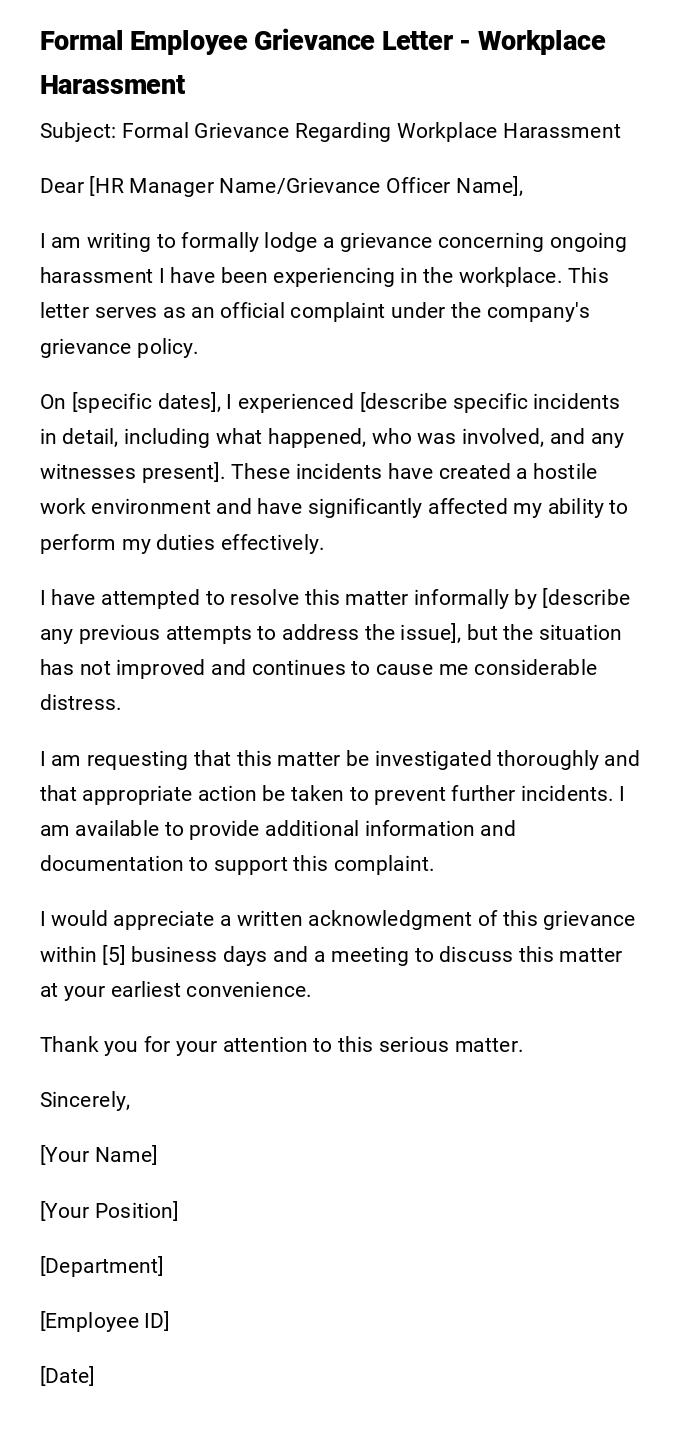
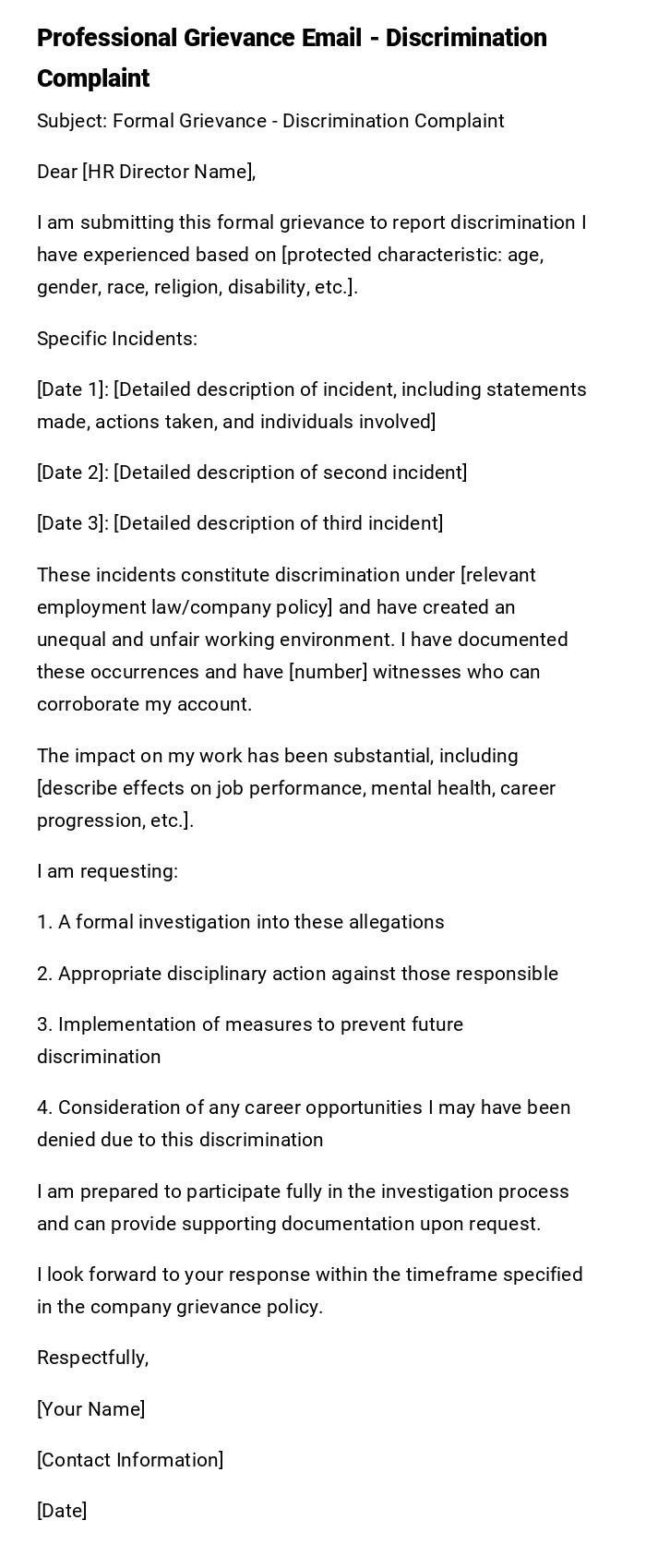
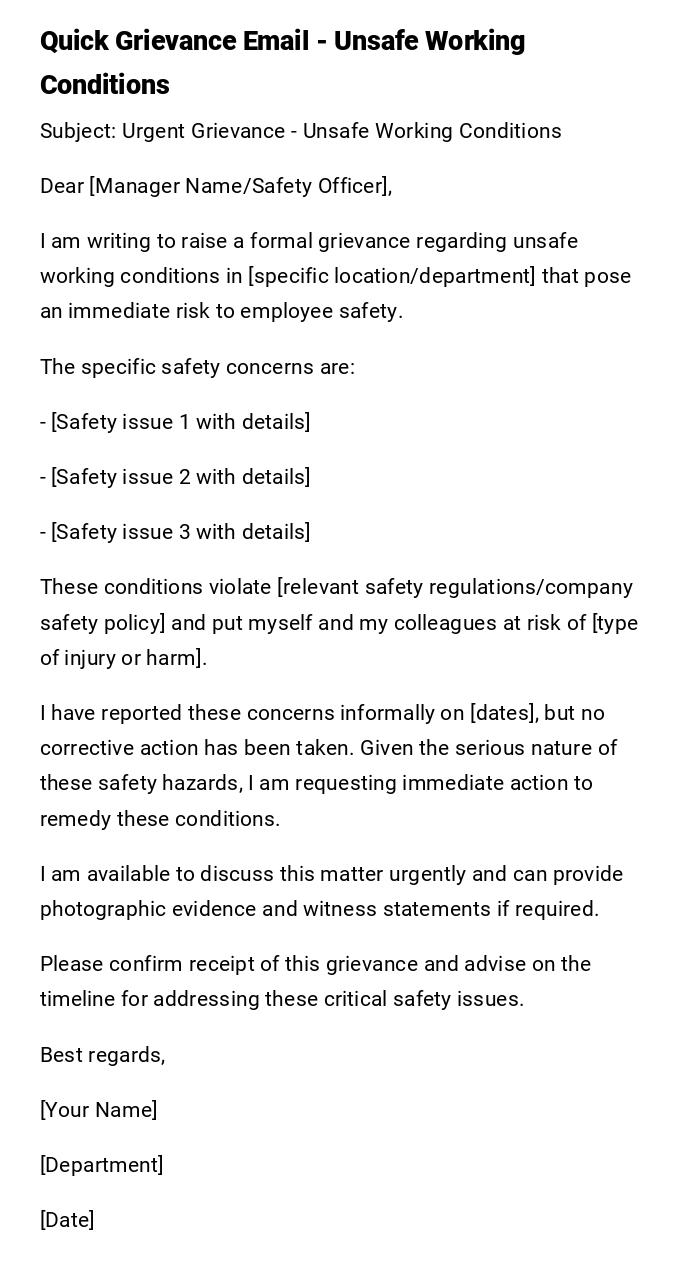
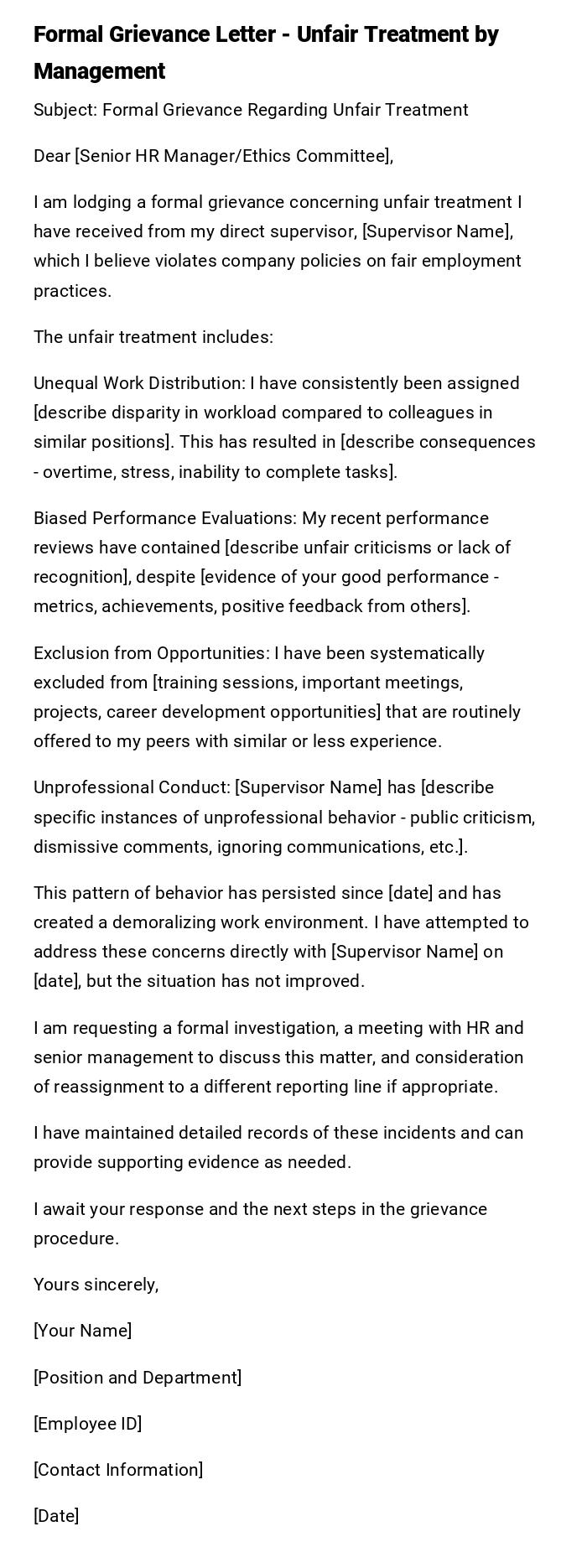
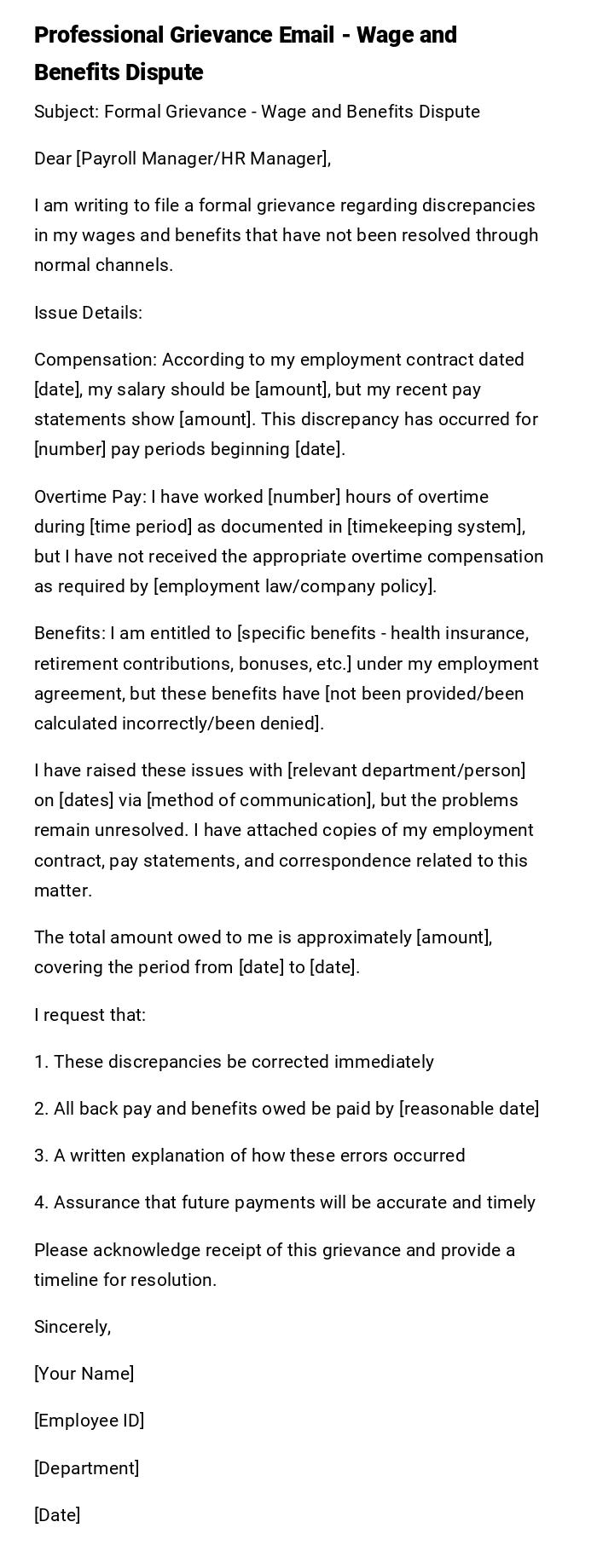

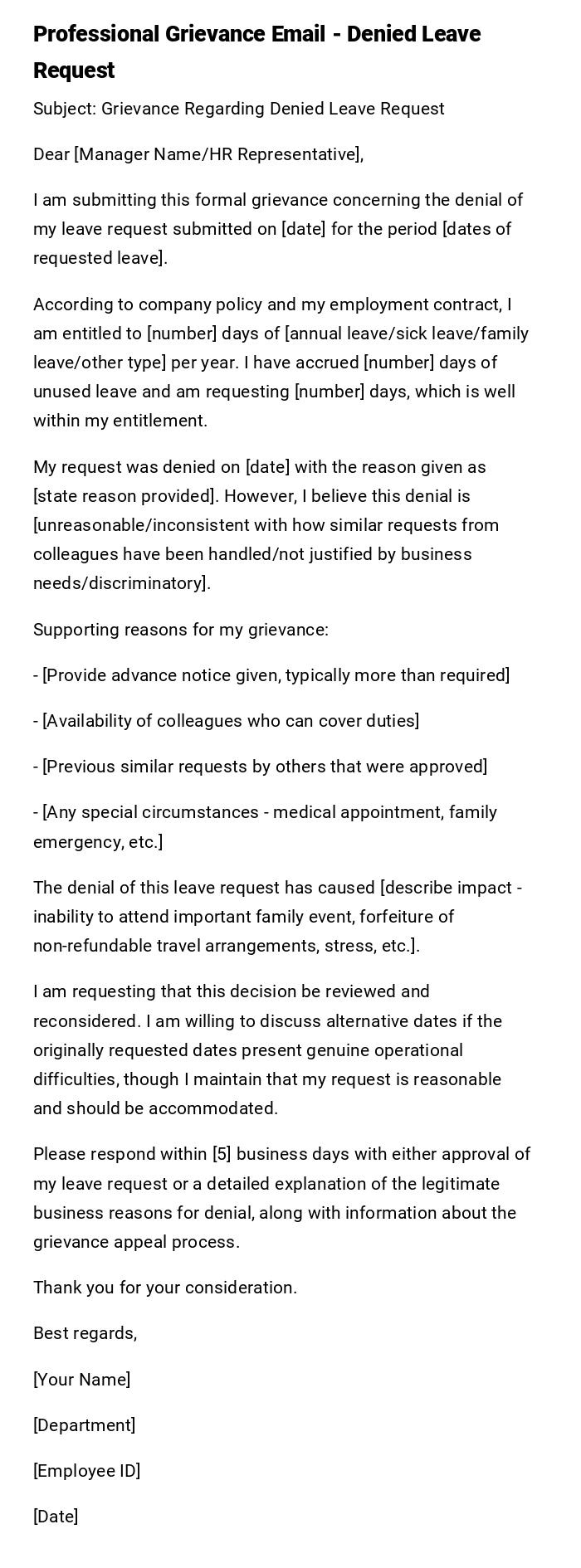


 Download Word Doc
Download Word Doc
 Download PDF
Download PDF